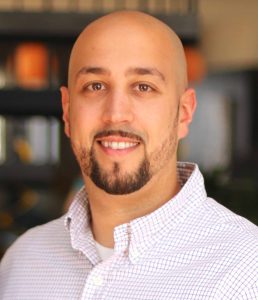Think globally, act locally
As the world’s largest research, education and museum complex, the Smithsonian has a long history, lofty ideals and bold plans for the future. For this first column of the new year—traditionally a time for reflection and optimism—I wanted to take a more intimate look at how we work to uphold those ideals. I asked a few of our colleagues to share their thoughts on how the Smithsonian can think globally by acting locally.
Relevance and resonance
As the Smithsonian works to broaden our reach and deepen our relevance, it is critical that we strengthen our ties to the communities we serve.
The Anacostia Community Museum, founded in 1967 as a small neighborhood museum, is an excellent example of how the Smithsonian can be a vibrant part of community life.
“My colleagues and I are truly proud of the successful launch of our year-long 50th anniversary celebration which began on September 15, 2017—exactly 50 years to the day from when our museum first opened,” says Samir Meghelli, chief curator of the Anacostia Community Museum.
“We debuted an exhibition to mark the milestone, ‘Your Community, Your Story: Celebrating Five Decades of the Anacostia Community Museum, 1967-2017,’” Samir continues. “I spend much of my time in neighborhoods across the city and region, listening to—and preserving the history of—individuals and communities, often those whose stories have gone under-documented. I consider it a real privilege—and also an incredible honor—to be able to do that work with and for the many communities who are our collaborators. I am most focused on building connections that begin locally but which reach globally. It keeps me excited about the work I get to do each day.”
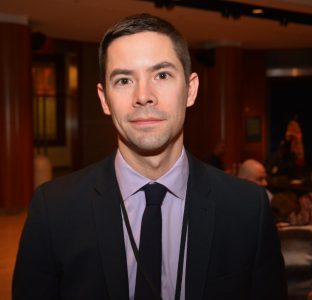
Joshua Voda, Public Affairs Specialist for the National Museum of the American Indian, George Gustav Heye Center, in New York City. (Photo courtesy of Josh Voda)
Joshua Voda, public affairs specialist with the National Museum of the American Indian in New York, also relishes the opportunity he has each day to make connections with communities. “The best part of my job is helping connect people with knowledge that improves their understanding of Native cultures and how important their experiences are within the broader context of American history,” he says. “It’s somewhat shocking to me at times how little the average person knows about Native people of the Americas. Our historical exhibitions strive to tell stories that fill in gaps that dominant histories gloss over or leave out altogether. Even when we have a very contemporary exhibition, you quickly realize how many people are surprised Native Americans are ‘still around’ or didn’t ‘die out’ years ago. I hope people come away from our programs and exhibitions more informed, more curious and less inclined to rely on stereotypes that permeate ideas of ‘native-ness.’”
However, the stories of our cultures lose their resonance if we don’t understand the world in which those cultures exist. The Smithsonian Environmental Research Center (SERC) in Edgewater, Md., explains environmental science in innovative ways that change how people view the biosphere and inspire them to take an active role in sustainable stewardship of the Earth.
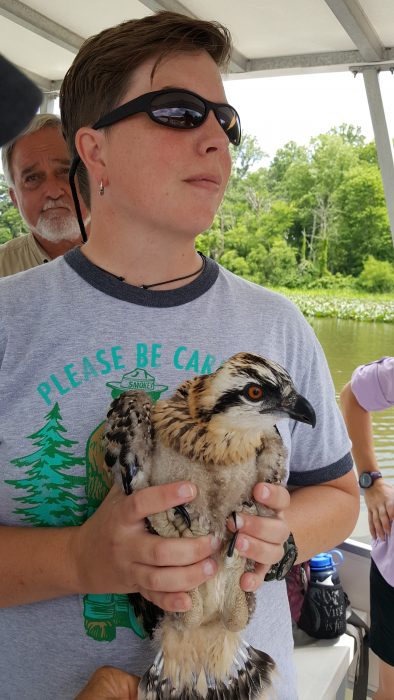
Karen McDonald, Education Program Coordinator for the Smithsonian Environmental Research Center, holds an osprey during a recent banding trip on the Patuxent River in Maryland. (Photo courtesy Karen McDonald)
Karen McDonald coordinates education programs for SERC, writes curricula, collaborates with scientists, and manages a core of about 50 volunteers who bring hands-on science to people of all ages in the community. “I’m most looking forward to the new programs in Public Engagement we are creating at SERC,” she says. “We’re building a phenomenal team of people in citizen science, science media and education to grow and enhance our program as a unified team. We’re starting to develop new curricula based on SERC research—ranging from orchids in the classroom in D.C. and Florida to MarineGEO (Global Earth Observatory) and the Movement of Life Initiative. We are also laying the foundation for a teacher’s academy that focuses on the practices and techniques of science. This will teach teachers about real world science processes using Smithsonian research at SERC as an example. Teachers can then take the information they learn back into the classroom to support students in hands-on learning by modeling real techniques.”
The MarineGeo project, directed by the Smithsonian’s Tennenbaum Marine Observatories Network (TMON), is the first long-term, worldwide research program to focus on understanding coastal marine life and its role in maintaining resilient ecosystems around the world. Emmet Duffy, TMON’s director, describes how this network of communities come together to make a global impact: “One of the biggest thrills of 2017 for the MarineGEO program was assembling a team of nearly 100 colleagues from around the world for an unprecedented field campaign to understand the changing marine life of Hawaii’s coral reefs. We had experts from Smithsonian science units, local high school and college students, elders of the native Hawaiian community, and colleagues from Japan, Europe, Brazil and all over the U.S., all diving together and working late into the night in one giant lab, powered by the passion to discover new creatures and understand how they are responding to global change. We found over a thousand species, including animals new to science, living fossils, and new invasive species, and fired up a new generation of Hawaiian environmental scientists. To me this was a golden example of the Smithsonian’s power to bring people together toward a common purpose.”
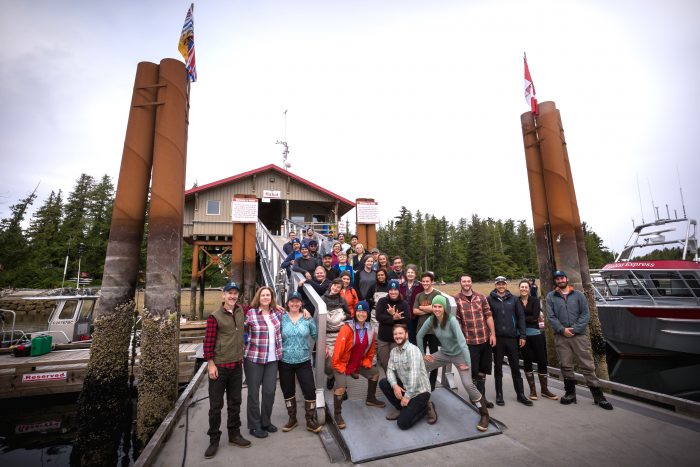
Emmett Duffy (far left, in red plaid shirt) poses with his research team during a recent field trip to British Columbia. (Photo courtesy Emmett Duffy)
What can we do better?
One of the goals of our new strategic plan is for the Smithsonian to reach a billion people by 2022. Like a pebble dropped in a pond, the ripple effect of our efforts on the community level can expand almost exponentially.
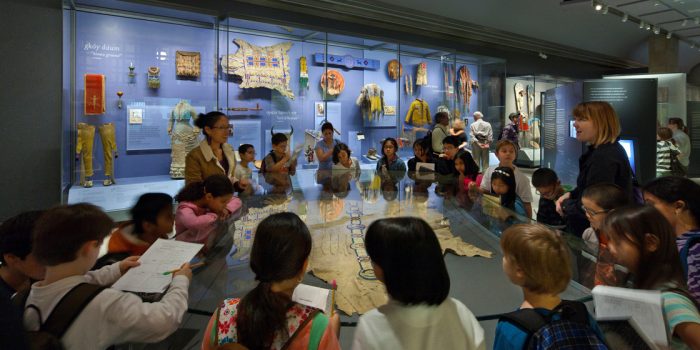
School children examine an Apsáalooke warrior’s exploit robe,
ca. 1850 in the “Infinity of Nations” exhibition at the National Museum of the American Indian. (Photo by David Sundberg)
“The work our teams accomplish to provide members of the media, government and communities with Smithsonian content is integral to reaching the ambitious goal of 1 billion people worldwide by 2022,” Josh says. “I think as we move forward in this new strategic plan, we must not only be efficient, but very purposeful in the audiences we are trying to reach and use tailored messaging for various groups. To keep up with the rapid-fire pace of technological progress, this necessarily means strengthening our digital outreach. We will find most success by instituting these practices in our own museums, but even more so by working toward collaborative communications and marketing goals throughout the units and fully embracing the ‘Be One Smithsonian’ goal of the strategic plan. We have the opportunity this next year to refine the best practices that will take us to 2022 and beyond.”
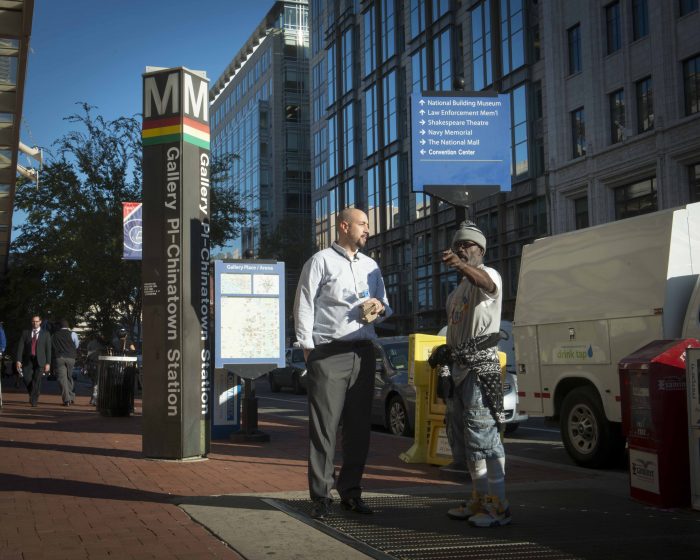
Curator Samir Meghelli has conducted more than 150 oral histories over the past two years as part of the documentation efforts for the forthcoming “A Right to the City” exhibition. Here he speaks with a gentleman in Chinatown, one of the neighborhoods featured in the exhibition. (Photo by Susana Raab)
“With each project and exhibition, we foster connections so that far-flung communities enter into dialogue with one another and begin to see the common humanity and common issues that bind us, with the ultimate goal of inspiring collaborative action to address urgent issues of our time,” Samir says. “We at ACM intend to do our part to exponentially grow the Institution’s reach, all the while ensuring that the connections we make are substantive and meaningful.”
“We are reaching people every day through our growing global network of research collaborators and students,” Emmett adds. “The Smithsonian allows us to set our sights on the biggest and most exciting challenges in science—where does biodiversity come from? How and why are the rich variety of ocean species important to people, and how can we keep the ocean healthy? There is no other institution on earth where we could build this global network.”

Leslie Poster, editor at the National Museum of American History, with some particularly patriotic colleagues. (Photo courtesy Leslie Poster)
Leslie Poster, editor at the National Museum of American History, offers a final insight: “As an editor, and just as a person, I think it’s critically important to communicate in a way that invites and includes all people. My New Year’s resolution for the Smithsonian is to talk more to our audience—not at them, and not about them, but to them. We can be the place where people engage in meaningful conversations about our world.”
I am committed to engaging in these meaningful conversations, not only with our constituencies around the world, but also with you, my colleagues. I rely on you to help us forge the Smithsonian’s path into the future. Thank you for all that you do. And happy new year.
Posted: 16 January 2018
